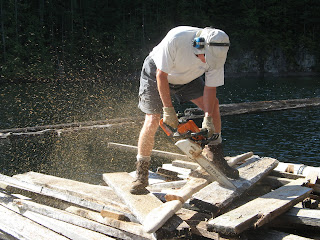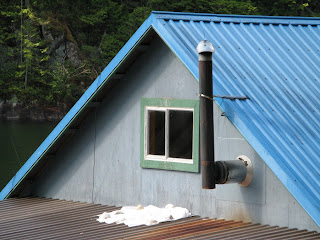Stuffing the Woodshed
 Winter on Powell Lake can be cold, especially when a storm blows in on a strong southeaster. Because our cabin floats on the water, it also gets damp. Starting in early fall, our Kozi woodstove becomes the heart of our little cabin. Consequently, a large supply of firewood is needed for winter heating.
Winter on Powell Lake can be cold, especially when a storm blows in on a strong southeaster. Because our cabin floats on the water, it also gets damp. Starting in early fall, our Kozi woodstove becomes the heart of our little cabin. Consequently, a large supply of firewood is needed for winter heating.

 A few tubs of kindling are stored in the cabin for easy use. A few more are under the front porch and the remaining ones are stored in our tool shed on shore. Extra firewood is placed in a recycled dinghy. As one tub is emptied, it is refilled with the waiting wood. We've learned to be careful with tubs from the shed. Occasionally, a mouse has taken up residence. Transferring the wood to an empty tub before bringing it into the cabin has solved this "little" problem.
A few tubs of kindling are stored in the cabin for easy use. A few more are under the front porch and the remaining ones are stored in our tool shed on shore. Extra firewood is placed in a recycled dinghy. As one tub is emptied, it is refilled with the waiting wood. We've learned to be careful with tubs from the shed. Occasionally, a mouse has taken up residence. Transferring the wood to an empty tub before bringing it into the cabin has solved this "little" problem.
 We are selective when it comes to the larger chunks of wood. First, they must be lifted out of the water for cutting. This limits the size to ones Wayne and I can haul aboard. We like skinny chunks that do not need splitting, but do get fatter ones if there are only a few knots. I hate holding the axe while Wayne wields the sledge hammer and it resounds off a knot.
We are selective when it comes to the larger chunks of wood. First, they must be lifted out of the water for cutting. This limits the size to ones Wayne and I can haul aboard. We like skinny chunks that do not need splitting, but do get fatter ones if there are only a few knots. I hate holding the axe while Wayne wields the sledge hammer and it resounds off a knot.

 We use a shelf I constructed for wood storage inside the cabin. It handily holds about five days worth of wood near the fire. If you want more information about how to make the shelf click here.
We use a shelf I constructed for wood storage inside the cabin. It handily holds about five days worth of wood near the fire. If you want more information about how to make the shelf click here.
Thanks to our end-of-summer wood work, we'll stay warm this winter. -- Margy







































